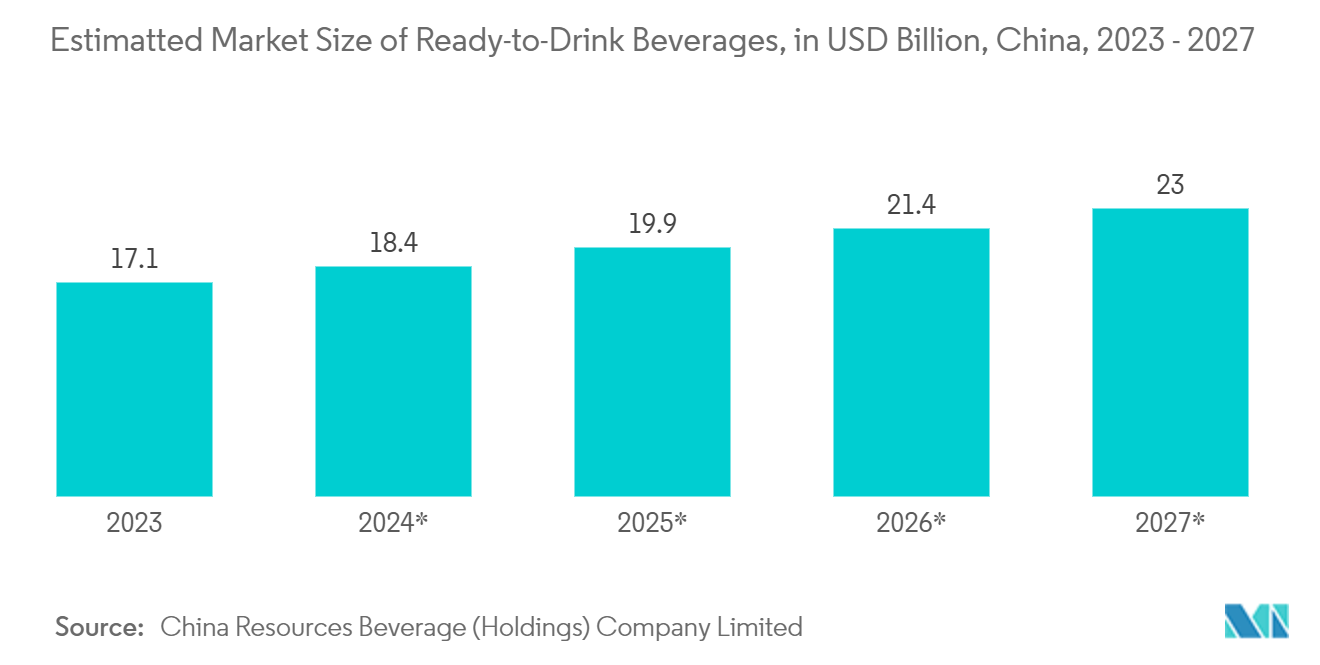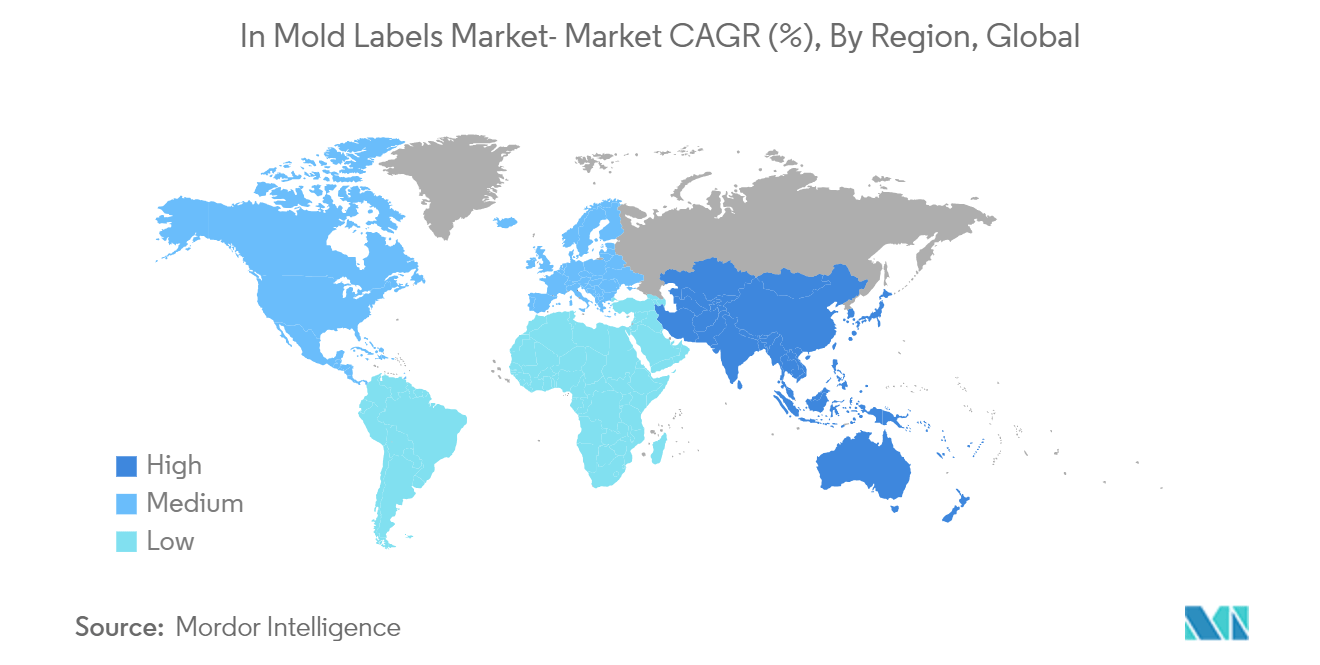Market Trends of In Mold Labels Industry
The Beverage Industry is Expected to Hold the Largest Share of the Market
- The beverage industry is expected to widely adopt in-mold labeling due to the importance of packaging aesthetics. Adequate packaging helps extend product shelf life and attracts potential customers. In-mold labeling offers several advantages, including durability, resistance to moisture and temperature changes, and seamless integration with the container. This technology allows for high-quality, photorealistic images to be incorporated directly into the packaging, enhancing brand visibility and product appeal. Additionally, in-mold labeling can reduce packaging costs in the long run by eliminating the need for separate labeling processes and materials.
- In-mold labeled containers in beverage packaging offer several advantages. They provide design flexibility, allowing manufacturers to create unique, eye-catching packaging solutions. These containers enhance product aesthetics by integrating high-quality graphics directly into the packaging material. IML technology reduces additional costs associated with separate labeling processes and equipment. Furthermore, IML containers are environmentally friendly, as they often use recyclable materials and eliminate the need for adhesives.
- Additionally, IML containers allow for unique shapes and designs with wrap-around labels, creating distinctive end products that stand out on store shelves. This packaging method also offers improved durability and resistance to moisture, making it suitable for various beverage types and storage conditions.
- In-mold labels comprise a high-barrier material layer between two polypropylene layers. This structure provides excellent protection, making in-mold labels suitable for the beverage industry. The labels enhance the shelf life of products such as carbonated soft drinks and juices by preventing moisture and gas permeation. The multi-layer construction also offers improved durability and resistance to environmental factors, ensuring that product information and branding remain intact throughout the product's lifecycle.
- The beverage industry, especially in emerging markets, has been a significant driver for in-mold label adoption. In 2023, China's ready-to-drink beverage market was valued at USD 17.1 billion, with projections indicating it will reach USD 23 billion by 2027. This growth in the beverage market is expected to drive the demand for in-mold labels in this category. Consumer preference for convenience and on-the-go consumption has increased the demand for packaged beverages, fueling the need for high-quality, durable labeling solutions like in-mold labels.
- Additionally, in-mold labeling offers advantages in production efficiency and sustainability. The labels are applied during molding, eliminating the need for separate labeling operations and reducing packaging costs. This integrated approach also minimizes material waste and energy consumption, aligning with the growing emphasis on sustainable packaging solutions in the beverage industry.
- The in-mold labels (IML) market is growing due to increased demand for eco-friendly, high-performance labels and improved manufacturing technologies. The beverage industry is adopting IML at a faster rate, driven by the need for packaged and branded products. IML offers benefits such as visual appeal, durability, and anti-counterfeiting features, making it particularly valuable in the soft drink and alcoholic beverage industries.

Asia-Pacific is Expected to Register the Fastest Growth Rate
- The demand for innovative, personalized, and high-quality labels is expected to be driven by the extensive customization options available for in-mold labels and the rising demand from end-user industries in Asia-Pacific. These customization options allow manufacturers to create unique, eye-catching designs to help products stand out on store shelves. The increasing consumer preference for products with distinctive packaging has led many companies to invest in advanced labeling technologies.
- Furthermore, the increasing disposable income and changing lifestyles are also contributing to this trend. As Asian consumers experience economic growth, they are more willing to spend on premium products with attractive packaging. This shift in consumer behavior has prompted brands to focus on enhancing their product presentation, including using high-quality labels. The changing lifestyles, particularly in urban areas, have also emphasized convenience and aesthetics in product packaging, further driving the demand for sophisticated labeling solutions.
- Developing economies like India, China, Indonesia, and Malaysia present substantial growth opportunities for the packaging industry. The rising per capita and disposable incomes in these countries drive significant industry growth as the demand for various packaged products increases. This trend is particularly evident in urban areas, where changing lifestyles and consumption patterns favor convenience and ready-to-eat products.
- Additionally, the expanding middle class in these nations is fueling demand for premium and branded goods, further boosting the packaging industry. The growth of the e-commerce and retail industries in these economies also contributes to the increased need for innovative and sustainable label solutions. As these countries continue to industrialize and urbanize, the packaging industry is expected to play a crucial role in supporting economic development and meeting evolving consumer needs.
- The labeling industry in India shows significant growth potential, primarily due to increasing demand for packaging solutions across various product categories. The need for high-quality, efficient labeling equipment fuels the expansion of the labeling machine industry.
- Additionally, government initiatives to raise consumer awareness about accurate labeling are supporting the industry's growth. Companies in this industry are focusing on innovation to meet market demands. For example, in March 2024, Mold-Tek Packaging Limited, a prominent player in the Indian packaging industry, invested in a Durst RSCi 510 mm press with priming and varnishing stations to enhance digital printing capabilities for in-mold labels.
- Fast-moving consumer goods (FMCG) is the fourth largest sector in the Indian economy. India's FMCG landscape comprises three main segments, namely food and beverage, household and personal care, and healthcare. These segments encompass a wide range of high-demand products and have a rapid turnover rate.
- In 2020, the country's FMCG market was valued at USD 110 billion. This substantial valuation reflects the sector's importance in India's economic landscape and its significant contribution to the country's GDP. The FMCG market's growth is driven by increasing urbanization, rising disposable incomes, and changing consumer preferences. In 2027, the market is expected to be valued at USD 615 billion. This remarkable growth forecast underscores the immense potential of the Indian FMCG sector. The expansion is likely to be fueled by population growth, increased rural consumption, and the adoption of modern retail formats.
- This expanding FMCG market significantly impacts the demand for packaging and labeling. As FMCG products require attractive and informative packaging to stand out on retail shelves, the growth in this sector directly translates to increased demand for packaging solutions. This trend creates substantial opportunities for various packaging technologies, including in-mold labeling, in the region.


